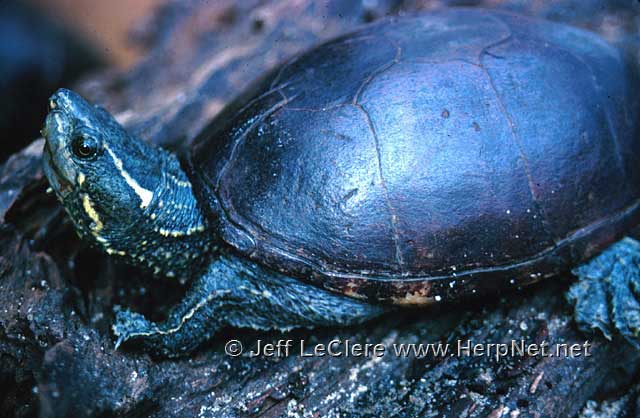Eastern Musk Turtle (Sternotherus odoratus)
Alternate names: Stinkpot
by Jeff LeClere

Status
THREATENED and Species of Greatest Conservation Need. It is illegal to kill or collect this species by law in Iowa. Eastern musk turtles are secretive and rarely bask. They may be caught while fishing in the Mississippi or its backwaters.
Description
The eastern musk turtle, or stinkpot, is Iowa’s smallest turtle species. Adults are only 4 1/2 inches long carapace length. The carapace is dark with no markings. It is rather arched, but as the turtle gets older, the shell may flatten on the top. The carapace is oblong shaped. The plastron is very small and shaped similarly to a snapping turtle’s plastron. The bridges are very narrow giving the plastron a plus-shape.
There is skin present between the seams of the plastron, especially in males. There is a single hinge near the front, but one must often look closely to see it. The ground color of the skin is black or dark olive. There are no markings on the skin except for two yellow or white lines on each side of the head. The absence of markings, as well as the appearance of the plastron, distinguishes the stinkpot from all other Iowa turtles. Males are slightly larger than females and have a longer, thicker tail. Hatchling stinkpots are less than an inch. They have a vertebral keel at this age, but unlike the map turtles, they have only two light lines on the side of the head and an unmarked, plus-shaped plastron.

Subspecies
No subspecies of the eastern musk turtle, Sternotherus odoratus, are recognized.
Range
The eastern musk turtle is found in scattered populations along the Mississippi River in eastern Iowa. They have been recorded in Wisconsin from the Wisconsin River (Vogt, 1981). This river is connected to the Mississippi River and specimens have been found in the Mississippi River along the Wisconsin border (Oldfield and Moriarty, 1994). Therefore, this turtle is probably found in suitable habitat along the Mississippi River in northern Iowa. If anyone finds specimens in northeastern Iowa, report it!

Habitat
Eastern musk turtles are found in sluggish backwaters, marshes, ponds, and ditches with soft bottoms and surrounding sandy soils close to the Mississippi River in Iowa.
Habits
The eastern musk turtle was first recorded from Iowa in 1955 (Dodge, 1956). Since then, a few new populations have been added. They become active in April, and overwinter beginning of October. These turtles bask only very rarely and are seldom seen. Stinkpots are mainly nocturnal, especially in the warmest summer months. They are also active in the morning and at dusk. During the day, they bury themselves in the mud, or sleep among aquatic vegetation. They stay close to the water, and have very restricted overland movements, if any. Eastern musk turtles have shown to dehydrate quicker than other turtles when kept dry (Ernst, 1968b).
Eastern musk turtles or stinkpots are so named due to musk glands that are present near the bridge connecting the carapace to the plastron. The musk can be very strong smelling in recently captured specimens. Stinkpots are also fairly aggressive when restrained. They attempt to bite, but it is easy to avoid their jaws when properly handling this species.
Male stinkpots mature at four to seven years of age and females at nine to eleven. They mature at the higher end of these times in the northern parts of their range. Most mating activity occurs in spring, but there is evidence that they will sometimes mate in the fall and females will store sperm until ovulation in the spring.
Females nest in June or July. A captive female laid 6 eggs on July 5 (Dodge, 1955). Females select sandy sites to dig nests. Some specimens choose sunny areas while others may choose nests in the shade. This may be an evolutionary selection to balance the sex ratio. Males are produced at mainly lower temperatures and females at higher temperatures. Nests may be very shallow. Females normal clutch size varies from 2 to 5 eggs, however, workers finding higher clutch sizes and several nests close together indicates the possibility of communal nesting, at least in some populations.
Average hatching times occur in August and September. Those reported by Dodge hatched September 14 and 15. The average size of a hatchling is about 20 mm long. There are no reports of hatchlings overwintering inside the nests.
Food
Eastern musk turtles consume mostly animal proteins when young, but as adults they tend to be omnivorous. Prey consumed are insects, crayfish, snails, fish, tadpoles, and nearly anything it can catch. They feed off the bottom of their marshy homes. They find their food by scent. Stinkpots are not fast, powerful swimmers. Therefore, it is unlikely that the fish and other fast moving prey are captured alive by these turtles. They are probably found dead; many references state that these turtles are scavengers. I have seen a group of stinkpots feeding on the carrion of a drowned nutria in Louisiana. These turtles are often caught while fishing. If you capture a stinkpot while fishing in Iowa, try remove it with as little damage to the turtle as possible. Take some pictures and report it to the DNR or us.





